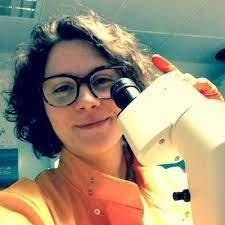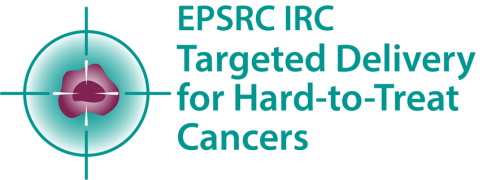Dr Giulia Emanuelli worked with the IRC from 2021 to 2023. Now a Postdoctoral Fellow in Cancer Research in the Yuneva Lab at the Francis Crick Institute, she talks about her research on MOFs and mesothelioma, her personal connection with the disease and the important lessons she’s learned from the IRC.
“The IRC is the most multidisciplinary group I’ve ever been part of. As an early career researcher, the IRC has been really inspiring. Seeing how people from other disciplines look at the same problem – and seeing how you can generate added power to your research by seeing things through more than one lens – has been such a valuable lesson to learn” - Dr Giulia Emanuelli, Postdoctoral Training Fellow at the Francis Crick Institute.
In November 2023, I started out on a new adventure at the Francis Crick Institute. I have joined the group of Dr Mariia Yuneva, a cancer metabolism scientist working on new strategies for treating people with recurrent cancer using metabolic targeted therapies.
Although we have many drugs that are good at eradicating cancer, it is a plastic disease. This means it’s very good at adapting to anti-cancer drugs by changing its metabolism to exploit different nutrients. When a cancer adapts to the anti-cancer drug, it becomes addicted to the new nutrients it needs from its rewired metabolism and we are looking for ways to exploit the weakness created by this ‘metabolic addiction’. The Yuneva lab works on breast cancer and liver cancer, and I will be working on two childhood cancers – neuroblastoma and medulloblastoma.
At Cambridge, I was part of Professor Stefan Marciniak’s lab for four years. He has a long-standing interest in mesothelioma and is part of Mesobank, the UK’s largest collection of high-quality tissue, cells and blood samples from pleural mesothelioma patients, which provides samples for a wide range of mesothelioma research. In the Marciniak lab, I was screening mesothelioma cells to identify the genes that are necessary for mesothelioma cells’ survival. Then in 2021, there was an opportunity to join the IRC and I jumped at the chance to expand our research on mesothelioma in a collaborative environment.
One of the greatest things about the IRC is that it’s very interdisciplinary, it covers a wide range of disciplines from materials science and engineering to medicine and biology. As an early career researcher it’s really inspiring to see how people from other disciplines look at the same problem; you can really generate this added power to what you do if you can view things through more than one lens. The IRC is also very collaborative, and that’s very important for an early career researcher. It allowed me to gain a lot more experience, including the soft skills that come with working with PhD students. It was my first postdoc position so it was very different being on the other side of the student-teacher relationship, learning how to drive this relationship in a different way.
My main collaboration in the IRC was with Professor David Fairen-Jimenez’s lab. They engineer and produce nanoparticles called metal organic frameworks (MOFs) and I worked on two parallel projects with two different MOFs. Within the IRC, engineers and materials scientists are generating materials informed by knowledge from clinicians about what kind of drugs they’d like to be able to load into these new materials and what kind of properties these materials need so that they are biocompatible. My task was to test the toxicity of these materials in normal cells, the tolerance of mesothelioma cells to these materials (both when they were unloaded and then loaded with a drug), how effective they were at killing mesothelioma cells and under what conditions. Using super resolution microscopy, we demonstrated that the cells are actually very good at taking up and accumulating these materials.
This knowledge is important because at the end, it enables one to select a set of optimal materials and conditions for other IRC partners to take forward – in this case Professor Judy Coulson and Dr Sarah Barnett at the University of Liverpool. My work allowed them to study these materials in the hen’s egg model in a more focussed and targeted way. That’s a key strength of the IRC. Collaborating closely within the IRC meant that small details – like sonicating a material before applying it to cells or how quickly you could expect to see cells starting to take up these materials – could be passed on easily. Because we kept talking to each other, it helped us design better experiments. This networked approach works really well.
Our results should be published in two peer-reviewed papers in 2024. The first is already at the revision stage and the second is being prepared. For me, one of the most inspiring elements of the IRC is the ‘meet the researchers’ events. It was something I’d never done before – meeting patients and their families, giving presentations to non-scientists and answering question on future treatments for mesothelioma. This kind of public engagement is really important. Science needs to be public facing. It aids understanding, gives people a more realistic view of research and the scientific process, and it keeps people engaged. That’s crucial, particularly now. Scientists want to help people and they have very clear aims, that’s why these therapies are being developed.
Working on mesothelioma has had a special resonance for me. In 2023, two family friends were diagnosed with mesothelioma, one of whom died in December. Even though the use of asbestos has been banned for years, the long latency of the disease means that the number of cases is still increasing, especially in countries like Italy. I will be building on all these valuable lessons in my new post in the Yuneva lab at the Francis Crick Institute in London. The IRC is both innovative and inspiring, seeing engineers, materials scientists, biomedical scientists and clinicians working so effectively together towards a shared goal. And it gives me confidence that these new high-capacity vehicles, injectable gels, and implantable devices are the therapies of the future.



